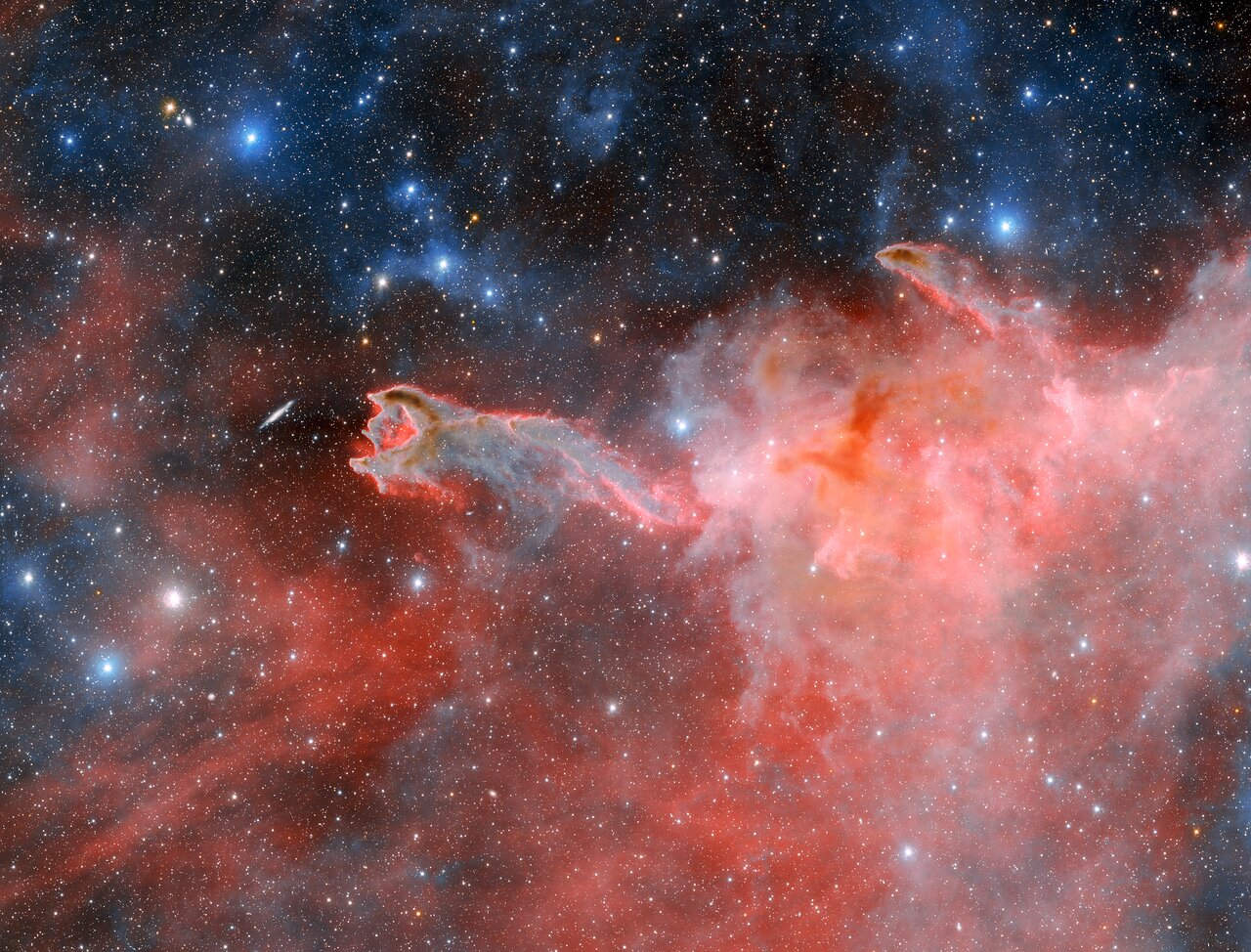Cometary globules are a subclass of the dark nebulae known as Bok globules — isolated clouds of dense cosmic gas and dust surrounded by hot, ionized material. When these clouds exhibit stripping of material that results in an extended tail, they are referred to as cometary globules because of their vague resemblance to a comet, though they have nothing in common. The features that classify CG 4 as a cometary globule are hard to miss in this image captured with the Department of Energy-fabricated Dark Energy Camera (DECam) mounted on the U.S. National Science Foundation Víctor M. Blanco 4-meter Telescope at Cerro Tololo Inter-American Observatory (CTIO), a Program of NSF NOIRLab. Its dusty head, which has a diameter of 1.5 light-years, and its long, faint tail, which is about eight light-years long, make CG 4 a comparatively small Bok globule, a general characteristic of cometary globules.
First recognized in 1976 from pictures taken with the UK Schmidt Telescope in Australia, cometary globules went undetected by astronomers for a long time because they are so faint. Their tails, shrouded in dark stellar dust, block most light from passing through. But with its special Hydrogen-alpha filter [1], DECam can pick up the faint red glow of ionized hydrogen present within CG 4’s head and around its outer rim. This light is produced when hydrogen becomes excited after being bombarded by radiation from nearby hot, massive stars.
The intense radiation generated by these neighboring massive stars, however, is gradually destroying the head of the globule and sweeping away the tiny particles that scatter the starlight. Still, the dusty cloud of CG 4 contains enough gas to feed the active formation of several new, Sun-sized stars.
While astronomers have observed these structures throughout the Milky Way, the overwhelming majority of them, including CG 4, are found within a huge patch of glowing gas called the Gum Nebula. Believed to be the expanding remains of a supernova that took place about a million years ago, the Gum Nebula is currently known to contain at least 31 cometary globules in addition to CG 4.
The mechanism by which these comet-like objects get their distinct shape is not entirely known, but astronomers have developed two main ideas about their origins. The first idea is that they could have originally been spherical nebulae — like the well-known Ring Nebula — which were then disrupted by a nearby supernova explosion, possibly the original explosion that created the Gum Nebula.
The second idea is that cometary globules are shaped by a combination of stellar winds and radiation pressure from nearby hot, massive stars. In fact, all of the cometary globules found within the Gum Nebula appear to have tails pointing away from the center of the nebula, which is where the Vela Supernova Remnant and Vela Pulsar are located. The Vela Pulsar is a rapidly spinning neutron star that was formed when a massive star collapsed, and it’s possible that its stellar winds and radiation pressure are shaping the nearby globules.
Also in this image it looks as if CG 4 is about to devour the edge-on spiral galaxy ESO 257-19 (PGC 21338), which appears to be placed so defenselessly in front of it. But in reality, this galaxy is more than a hundred million light-years beyond CG 4 and only appears to be close because of a chance alignment.
Notes
[1] At 62 cm (25 inches) in diameter, DECam’s narrow-band filters are some of the largest in operation anywhere. There are currently 11, centered on different wavelengths of interest, with 3 more being fabricated. Making narrow-band filters of this size that work in wide-field instruments like DECam is a significant technical challenge.
More information
NSF NOIRLab (U.S. National Science Foundation National Optical-Infrared Astronomy Research Laboratory), the U.S. center for ground-based optical-infrared astronomy, operates the International Gemini Observatory (a facility of NSF, NRC–Canada, ANID–Chile, MCTIC–Brazil, MINCyT–Argentina, and KASI–Republic of Korea), Kitt Peak National Observatory (KPNO), Cerro Tololo Inter-American Observatory (CTIO), the Community Science and Data Center (CSDC), and Vera C. Rubin Observatory (operated in cooperation with the Department of Energy’s SLAC National Accelerator Laboratory). It is managed by the Association of Universities for Research in Astronomy (AURA) under a cooperative agreement with NSF and is headquartered in Tucson, Arizona. The astronomical community is honored to have the opportunity to conduct astronomical research on I’oligam Du’ag (Kitt Peak) in Arizona, on Maunakea in Hawai‘i, and on Cerro Tololo and Cerro Pachón in Chile. We recognize and acknowledge the very significant cultural role and reverence that these sites have to the Tohono O’odham Nation, to the Native Hawaiian community, and to the local communities in Chile, respectively.
Links
- Explore CG 4 in more detail
- Photos of the Víctor M. Blanco 4-meter Telescope
- Videos of the Víctor M. Blanco 4-meter Telescope
- Photos of DECam
- Images taken by DECam
- Check out other NOIRLab Photo Releases


